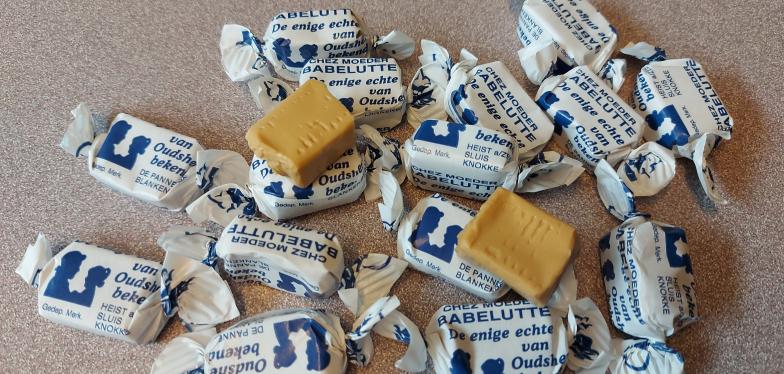Did you know that the first Babeluttes date from the 19th century?

If you went to the seaside as a child, your parents probably gave you a bag of 'babelutte' toffees from time to time. You know, those old-fashioned candies that were so typical of our coast and produced a delicious flavour in your mouth for several minutes. But what is this piece of pure nostalgia made of and where does it come from?
Babelutte, babbelaar, bonbons au beurre (butter candy) There are different names for the same traditional local delicacy, made of... candy sugar, caramel, glucose syrup, butter, coconut oil-based vegetable fat, a pinch of salt, and soya lecithin as an emulsifier. That is the complete list of ingredients in the real babelutte. The taste is deliciously creamy and sweet, making many people spontaneously think of sweet butter.
In the second half of the 19th century, a certain Rosalie Desmedt (1841-1912) accompanied her husband to the fishing village of Heist, which at that time was gradually becoming an important seaside resort on our North Sea coast. The young couple moved into the corner of the current Knokkestraat and Kursaalstraat. He was a carpenter, but in the summer months he could earn more on the beach selling 'boules de Berlin' doughnuts - another delicacy invariably associated with the coast - baked by his wife. It was a golden opportunity for her. Hadn't her mother taught her how to make the best babeluttes, with polder butter, like many fishermen's wives in those days? The ambitious Rosalie, who had a flair for business, marketed the delicacy and sold her "babblers" while still warm on a sheet of buttered paper to the elite English and French bathers staying in the elegant villas and hotels of Heist. It was an immediate success! In 2021, we can still see fishermen sitting on the wharf with a bag of babeluttes next to them, a habit apparently passed down from father to son.
From 'babbeloars' to 'babelutte' and from 'Mère Babelutte' to 'Moeder Babelutte'
The ingredients are used to make strips one finger thick and about ten centimetres long, which are then cut into smaller pieces. This part of the production process is said to have given 'babbeloar' its name in West Flemish, as the workers argued and left the sugar hanging too long. What about the word 'babelutte'? It's just the French version of 'babbelaar'.
French-speaking children affectionately called Rosalie 'Mère Babelutte'. Finally, Rosalie opened her own shop, Mère Babelutte, with the money she had earned. In the meantime, Moeder Babelutte has grown into a real family business with a dozen shops, one in each coastal town, in Bruges, and in Sluis in the Netherlands. Moeder Babelutte also sells pralines and nougat, in addition to its original recipe, sold twisted into its double white and blue butter wrapper. It gives you a real holiday feeling.